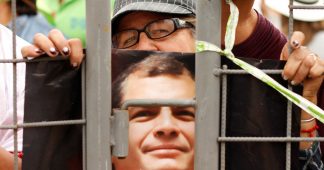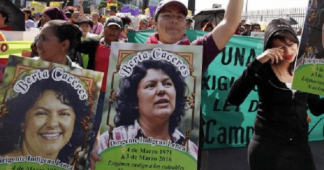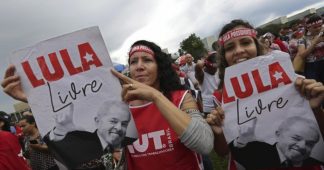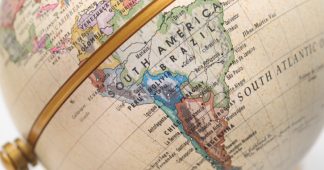And the first thing the American power structure doesn’t want any Negroes to start is thinking internationally. (Malcolm X – Autobiography)
Color is not a human or a personal reality; it is a political reality. (James Baldwin, The Fire Next Time)
By Franklin Frederick
The United States, with the complicity of local oligarchies, used lawfare to overthrow the governments of Manuel Zelaya in Honduras in 2009; Fernando Lugo in Paraguay in 2012 and Dima Rousseff in Brazil in 2016. Lawfare was also used for the political persecution of Christina Kirchner in Argentina, Rafael Correa in Ecuador, and former President Lula in Brazil. Lawfare has thus become the Empire’s main instrument to impede the advance of progressive forces in Latin America. Before its international application, however, lawfare was widely used by the United States in the oppression and political persecution of its own Black population in the struggle for racial equality and civil rights. Thus, the origin of lawfare is intrinsically linked to racism and the maintenance of the hierarchies imposed by capitalism.
The African-American writer Charles Chesnutt, in the article ‘The Courts and the Negro’, published in 1908, already recognized it:
The function of courts in the organization of modern society is to protect rights; to pass upon disputes between man and man or between the individual and the State; and then, by their mandate, to set in motion the arm of the executive to prevent or punish a wrong or to enforce a right. Obviously if this great power be not rightly exercised, if it be swayed by prejudice or class interest, justice will not be done. Nowhere in the history of our jurisprudence has this power of courts been more strongly exerted than in the matter of Negro rights, and nowhere has it been more swayed by prejudice and class interest.
With the liberation of slaves at the end of the Civil War in the United States, the defeated oligarchy of the southern states – the Confederacy – quickly organized itself to prevent African-Americans from using the vote to challenge the hierarchies of power. On the one hand, they used the various tribunals and the Supreme Court – as Chesnutt denounced in the above citation – in a lawfare that would prevent any advance in the conquest of rights and equality by African-Americans. On the other hand, the oligarchies have also widely used terror to keep African Americans permanently oppressed and away from voting. The parallel with United States’ action in Latin America could not be closer: to the lynchings and the terroriizing of the Ku Klux Klan correspond the various death squads of the regimes supported by the Empire: Somoza in Nicaragua, Pinochet in Chile, Stroessner in Paraguay and the murderous military dictatorships in Argentina and Brazil, among others. In the south of the U.S. or in Latin America, the objective is the same: to prevent social advances and any change in the hierarchy of power that challenges the capitalist system. The close connection between racism and capitalist exploitation was a fact recognized in the U.S. as early as the nineteenth century. Frederick Douglass, born a slave around 1818, a self-taught author who fled slavery and became perhaps the best-known American public figures of his time, was a profound analyst of the society in which he lived and, without having known Karl Marx, wrote:
The slaveholders, with a craftiness peculiar to themselves, by encouraging the enmity of the poor, laboring white man against the blacks, succeeds in making the said white man almost as much a slave as the black slave himself. The difference between the white slave, and the black slave, is this: the latter belongs to ONE slaveholder, and the former belongs to ALL the slaveholders, collectively. The white slave has taken from him, by indirection, what the black slave has taken from him, directly, and without ceremony. Both are plundered, and by the same plunderers. The slave is robbed, by his master, of all his earnings, above what is required for his bare physical necessities; and the white man is robbed by the slave system, of the just results of his labor, because he is flung into competition with a class of laborers who work without wages.
Carrying forth Douglass’ analysis into the twentieth century, the African-American intellectual W.E.B. Du Bois wrote in Black Reconstruction:
Black labor became the foundation stone not only of the Southern social structure, but of Northern manufacture and commerce, of the English factory system, of European commerce, of buying and selling on a world-wide scale; new cities were built on the results of black labor, and a new labor problem, involving all white labor, arose both in Europe and America. … Indeed, the plight of the white working class throughout the world today is directly traceable to Negro slavery in America, on which modern commerce and industry was founded, which persisted to threaten free labor until it was partially overthrown in 1863. The resulting color caste founded and retained by capitalism was adopted, forwarded and approved by white labor, and resulted in subordination of colored labor to white profits the world over. Thus the majority of the world’s laborers, by the insistence of white labor, became the basis of a system of industry which ruined democracy.
Capitalism would not have developed without slavery, and so the struggle against racism is fundamentally also the struggle against capitalism. It is not surprising, therefore, that lawfare is intrinsically linked to racism.
It was in the 1960s in the U.S. that the struggles of the progressive forces incarnated in the African-American movements for racial equality and civil rights reached their climax. It was only during this period that the main barriers imposed by lawfare to the advancement of civil rights of African-Americans finally fell, not without much struggle and much bloodshed.
Perhaps no other group has been more attacked by the capitalist order’s double strand of hierarchical power – lawfare and violent terror – than the Black Panther Party. And through the history of the Black Panther Party one can understand much better the recent history of Latin America and its relationship to the Empire.
Possibly the most complete history of the Black Panther Party is the book Black Against Empire – The History and Politics of the Black Panther Party by authors Joshua Bloom and Waldo E. Martin, Jr. In this study the authors wrote:
The Panthers saw black communities in the United States as a colony and the police as an occupying army. In a foundational 1967 essay, Newton [Huey Newton, one of the founders of the Black Panther] wrote, ‘There is a great similarity between the occupying army in Southeast Asia and the occupation of our communities by the racist police’. … In 1970, the Party had opened offices in sixty-eight cities from Salem, Wisconsin, to Omaha and Seattle. The Black Panther Party had become the center of a revolutionary movement in the United States.
FBI director J. Edgar Hoover famously declared, ‘The Black Panther Party, without question, represents the greatest threat to the internal security in the country’. … The federal government and the local police forces across the nation responded to the Panthers with an unparalleled campaign of repression and vilification. They fed defamatory stories to the press. They wiretapped Panther offices around the country. They hired dozens of informants to infiltrate Panther chapters. … In attacking the Black Panthers as enemies of the state, federal agents sought to repress not just the Party as an organization but the political possibility it represented.
Much more is known today about the role of the FBI in the campaign against the Black Panthers and the civil rights movement in general. Nelson Blackstock’s book COINTELPRO – The FBI’s Secret War on Political Freedom [COINTELPRO: for COunter INTELligence PROgram] is an excellent source of information on this subject. In this work the author states: ‘One of the things that come through clearest in the Cointelpro papers is that the FBI reserved a special hatred for the Black civil rights movement.’
Noam Chomsky, who wrote the introduction to the book, explains that the role of the FBI was ‘to block legal political activity that departs from orthodoxy, to disrupt opposition to state policy, to undermine the civil rights movement.’
Still in Chomsky’s words:
Predictably, the most serious of the FBI disruption programs were also those directed against the Black Nationalists. … Perhaps the most shocking story concerns the assassination of Fred Hampton and Mark Clark by Chicago police directed by the state’s attorney’s office in December 1969, in a predawn raid on a Chicago apartment. Hampton, one of the most promising leaders of the Black Panther party – particularly dangerous because of his opposition to violent acts or rhetoric and his success in community organizing – was killed in bed … there is now substantial evidence of direct FBI involvement in this gestapo-style political assassination.
It is no coincidence that the people most responsible for the putsch against elected President Dilma Rousseff in Brazil – Judge Sergio Moro and State Prosecutor Deltan Dallagnol – have allied themselves with the FBI in their efforts to criminalize former President Lula and the Worker’s Party (PT in Portuguese). The smear and criminalization campaigns against the Black Panther Party and the Worker’s Party in Brazil have much in common.
One of the Black Panther’s main programs was the distribution of food to poor African-American communities, especially children. The party also distributed clothing and organized medical care. Some of the centers where the Party distributed breakfast to children suffered bomb attacks, so violent was the reaction of the white and capitalist power hierarchy to the challenge posed by the Panthers. Some party leaders were murdered, others put in prison. As mentioned, the repression of the Black Panther through the combination of lawfare and violent terror was unprecedented but not without parallels: the Empire’s repression of social movements and leftist political parties in Latin America is similar in both action and motivation. The fundamental phrase in the above quote from Bloom and Martin’ book lays bare in all clarity the main objective of the Empire and its accomplices in Latin America: ‘In attacking the Black Panthers [or Lula, or the Worker’s Party, or Evo Morales, Rafael Correa, Christina Kirchner, Hugo Chávez, Nicolás Maduro] as enemies of the state, federal agents sought to repress not just the Party as an organization but the political possibility it represented.’
In 1981, Ronald Reagan took over the capitalist power hierarchy’s war against progressive social forces. In another important study on structural racism in the U.S. and its relation to security and repression policies – Incarcerating the Crisis – author Jordan T. Camp wrote:
The triumph of Reaganism marked the consolidation of a racial and security regime, a neoliberal regime that took shape during the Cold War counterinsurgency against the long civil rights movement. Reagan sent a message to whites that their economic problems were caused by people of color winning access to the social wage during the civil rights movement. … These neoliberal narratives defined the behaviour of the unemployed and social wager programs as the primary sources of economic insecurities. … [Reagan’s strategy was to] redirect resources away from investments in the public sector and toward an expanded budget for the neoliberal carceral-security state. … With Reagan’s election, Cold Warriors and neoliberals were able to capture state power and legitimate their class rule through appeals to security. In his first two years in the White House, Reagan doubled the FBI budget and increased the Federal Bureau of Prisons budget by 30 percent. The discourse of security was deployed as the major justification for the restructuring of the state form, much like the U.S. state’s legitimation of increased expenditures for aggressive counterinsurgency measures in Central America and apartheid South Africa in the 1980s. … By the early 1980s the U.S. imprisoned 420,000 people in federal and state prisons. Over the next decade the number of prisoners would increase more than 64 percent across the country. (…) The carceral population grew from two hundred thousand people in the late 1960s to more than 2.4 million people in the 2000s. Currently, one in thirty-five, or 6.9 million adults in the United States, are in jail or prison, or on parole or probation. Increased spending on incarceration has occurred alongside the reduction of expenditures for public education, transportation, health care, and public-sector employment. Prison expansion has coincided with a shift in the racial composition of prisoners from majority white to almost 70 percent people of color. The unemployed, underemployed, and never-employed Black and Latino poor have been incarcerated at disproportionate rates. With the highest rate of incarceration on the planet, the United States currently incarcerates Black people at rates higher than South Africa did before the end of Apartheid. All of these numbers bespeak a collision of race, class, and carceral state power without historical precedent, but certainly not without historical explanation.
This reformulation of the state by the Reagan regime still inspires the main political objectives of the Latin American oligarchies, with strong resistance from social movements and left-wing parties. The elections of Hugo Chavez, Lula, Evo Morales, Rafael Correa and Christina Kirchner were responses to the Empire’s attempt to promote ‘incarceration’ in Latin America.
Neoliberalism, which was born as a political reaction to capitalism’s ‘concessions’ to the ‘welfare state’, also became a reaction against the civilizing conquests of the 1960s. Hence the return of the most virulent forms of racism, of the attacks on the rights obtained by women and homosexuals. The maintenance of the capitalist hierarchy in its neoliberal stage depends fundamentally on the most reactionary part of the population. And neoliberalism, on the other hand, tries to reproduce and maintain these social forces.
The quotation from Malcolm X at the beginning of this text defines the fundamental political program of our time: the internationalization of the struggle against racism is an integral part of the construction of the international struggle against capitalism and its hierarchies of power.











